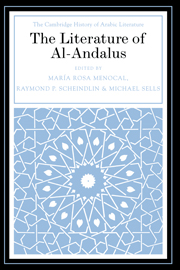Book contents
- Frontmatter
- 1 Visions of al-Andalus
- PART I THE SHAPES OF CULTURE
- PART II THE SHAPES OF LITERATURE
- PART III ANDALUSIANS
- 10 Ibn Ḥazm
- 11 Moses Ibn Ezra
- 12 Judah Halevi
- 13 Petrus Alfonsi
- 14 Ibn Quzmān
- 15 Ibn Zaydūn
- 16 Ibn Ṭufayl
- 17 Ibn ʿArabī
- 18 Ramon Llull
- 19 Ibn al-Khaṭīb
- The dual heritage in Sicilian monuments
- PART IV TO SICILY
- PART V MARRIAGES AND EXILES
- PART VI TO AL-ANDALUS, WOULD SHE RETURN THE GREETING
- Index
The dual heritage in Sicilian monuments
from 19 - Ibn al-Khaṭīb
Published online by Cambridge University Press: 28 May 2012
- Frontmatter
- 1 Visions of al-Andalus
- PART I THE SHAPES OF CULTURE
- PART II THE SHAPES OF LITERATURE
- PART III ANDALUSIANS
- 10 Ibn Ḥazm
- 11 Moses Ibn Ezra
- 12 Judah Halevi
- 13 Petrus Alfonsi
- 14 Ibn Quzmān
- 15 Ibn Zaydūn
- 16 Ibn Ṭufayl
- 17 Ibn ʿArabī
- 18 Ramon Llull
- 19 Ibn al-Khaṭīb
- The dual heritage in Sicilian monuments
- PART IV TO SICILY
- PART V MARRIAGES AND EXILES
- PART VI TO AL-ANDALUS, WOULD SHE RETURN THE GREETING
- Index
Summary
The architectural monuments of Norman Sicily reflect a dual heritage. While Monreale’s cathedral (built 1174–82) and Palermo’s Capella Palatina (c. 1140) served Christian religious purposes and communicated their message of salvation via figural representation, their program of ornamentation revealed a continuing interest in dazzling surface embellishment that was the legacy of Islamic visual culture. The predilection for domes on squinches, the patterned geometrical manipulation of brick and tile, and the use of hanging muqarnas (stacked niches that fill corners and disguise the transition from the vertical to the horizontal plane) in architectural interiors are examples of the persistence of the Islamic decorative aesthetic. La Zisa Palace, whose patron was William II (r. 1166–89), was one of many garden palaces and pavilions built by local Muslim craftsmen. Its halls featured a fountain with water pouring over a textured chute (chadar), the entirety crowned by a muqarnas half-dome, and stucco inscriptions in Arabic on the walls that praised the palace as paradise on earth. Gardens, interior fountains, and mural inscriptions were characteristic of Islamic palaces and demonstrate how easily Sicily’s Norman rulers adapted to the comfortable and luxurious Arab style of living.
The cathedral of Santa María Nuova at Monreale is a large basilica with an attached cloister. Its apse exterior is adorned with interlacing stilted arches that frame blind inner arches, resting on slender colonnettes. The textured terracotta and glazed-tile decoration of the enframing bands anticipates the Mudejar churches of Spain (*Mudejar Teruel) and was the product of Muslim artisans working in a largely unchanged ornamental tradition for a Christian patron. The structure of the building served Christian liturgy, but its skin was Islamic and reflected the mixed ethnic and religious population of Sicily under Norman rule.
- Type
- Chapter
- Information
- The Literature of Al-Andalus , pp. 373 - 374Publisher: Cambridge University PressPrint publication year: 2000



